Voet D., Voet Ju.G. Biochemistry
Подождите немного. Документ загружается.


Problems 481
1. Indicate the products of the YADH reaction with normal
acetaldehyde and NADH in D
2
O solution.
2. Indicate the product(s) of the YADH-catalyzed oxidation
of the chiral methanol derivative (R)-TDHCOH (where T is the
symbol for tritium).
3. The enzyme fumarase catalyzes the hydration of the double
bond of fumarate:
Predict the action of fumarase on maleate, the cis isomer of fu-
marate. Explain.
4. Write a balanced equation for the chymotrypsin-catalyzed
reaction between an ester and an amino acid.
5. Hominy grits, a regional delicacy of the southern United
States, is made from corn that has been soaked in a weak lye
(NaOH) solution.What is the function of this unusual treatment?
6. Which of the curves in Fig. 13-5 exhibits the greatest coop-
erativity? Explain.
7. What are the advantages of having the final product of a
multistep metabolic pathway inhibit the enzyme that catalyzes the
first step?
8. What are the systematic names and classification numbers
for the enzymes whose recommended names are hexokinase, di-
hydroorotase, and catalase?
9. Which type of enzyme (Table 13-3) catalyzes the following
reactions?
–
OOC H
H
C
C
COO
–
COO
–
COO
–
CHHO
CHH
Fumarate
L-Malate
H
2
O+
fumarase
CH
3
C
COO
_
H
NH
+
(a)
H
C
COO
_
H
3
C
(b)
CH
3
C
COO
_
O
+
H
+
+
H
+
CH
3
C
H
O
+
O
C
O
(c)
CH
3
C
COO
_
O
+
NADH
CH
3
C
H
+
HO
NAD
+
COO
_
(d)
C
COO
_
+
ATP
H
(CH
2
)
2
C
O
O
_
+
C
COO
_
+
ADP
H
(CH
2
)
2
C
O
+
P
i
NH
2
3
NH
+
3
NH
+
3
NH
+
4
NH
+
3
PROBLEMS
JWCL281_c13_467-481.qxd 2/18/10 11:27 AM Page 481
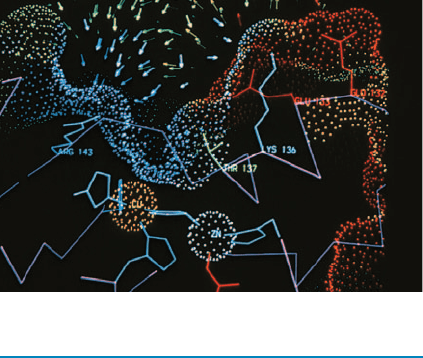
482
CHAPTER 14
Rates of Enzymatic
Reactions
1 Chemical Kinetics
A. Elementary Reactions
B. Rates of Reactions
C. Transition State Theory
2 Enzyme Kinetics
A. The Michaelis–Menten Equation
B. Analysis of Kinetic Data
C. Reversible Reactions
3 Inhibition
A. Competitive Inhibition
B. Uncompetitive Inhibition
C. Mixed Inhibition
4 Effects of pH
5 Bisubstrate Reactions
A. Terminology
B. Rate Equations
C. Differentiating Bisubstrate Mechanisms
D. Isotope Exchange
Appendix: Derivations of Michaelis–Menten
Equation Variants
A. The Michaelis–Menten Equation for Reversible Reactions—
Equation [14.30]
B. The Michaelis–Menten Equation for Uncompetitive
Inhibition—Equation [14.41]
C. The Michaelis–Menten Equation for Mixed Inhibition—
Equation [14.45]
D. The Michaelis–Menten Equation for Ionizable Enzymes—
Equation [14.47]
Kinetics is the study of the rates at which chemical reactions
occur. A major purpose of such a study is to gain an un-
derstanding of a reaction mechanism, that is, a detailed
description of the various steps in a reaction process and
the sequence with which they occur. Thermodynamics, as
we saw in Chapter 3, tells us whether a given process can
occur spontaneously but provides little indication as to the
nature or even the existence of its component steps. In con-
trast, the rate of a reaction and how this rate changes in
response to different conditions is intimately related to the
path followed by the reaction and is therefore indicative of
its reaction mechanism.
In this chapter, we take up the study of enzyme kinetics,
a subject that is of enormous practical importance in bio-
chemistry because:
1. It is through kinetic studies that the binding affinities
of substrates and inhibitors to an enzyme can be deter-
mined and that the maximum catalytic rate of an enzyme
can be established.
2. By observing how the rate of an enzymatic reaction
varies with the reaction conditions and combining this in-
formation with that obtained from chemical and structural
studies of the enzyme, the enzyme’s catalytic mechanism
may be elucidated.
3. Most enzymes, as we shall see in later chapters, func-
tion as members of metabolic pathways. The study of the
kinetics of an enzymatic reaction leads to an understanding
of that enzyme’s role in an overall metabolic process.
4. Under the proper conditions, the rate of an enzymat-
ically catalyzed reaction is proportional to the amount of
the enzyme present, and therefore most enzyme assays
(measurements of the amount of enzyme present) are
based on kinetic studies of the enzyme. Measurements of
enzymatically catalyzed reaction rates are therefore among
the most commonly employed procedures in biochemical
and clinical analyses.
We begin our consideration of enzyme kinetics by re-
viewing chemical kinetics because enzyme kinetics is based
on this formalism. Following that, we derive the basic equa-
tions of enzyme kinetics, describe the effects of inhibitors
on enzymes, and consider how the rates of enzymatic reac-
tions vary with pH. We end by outlining the kinetics of
complex enzymatic reactions.
Kinetics is, by and large, a mathematical subject. Al-
though the derivations of kinetic equations are occasion-
ally rather detailed, the level of mathematical skills it re-
quires should not challenge anyone who has studied
elementary calculus. Nevertheless, to prevent mathemati-
cal detail from obscuring the underlying enzymological
principles, the derivations of all but the most important ki-
netic equations have been collected in the appendix to this
chapter.Those who wish to cultivate a deeper understand-
ing of enzyme kinetics are urged to consult this appendix.
1 CHEMICAL KINETICS
Enzyme kinetics is a branch of chemical kinetics and, as
such, shares much of the same formalism. In this section we
JWCL281_c14_482-505.qxd 2/19/10 2:21 PM Page 482

shall therefore review the principles of chemical kinetics so
that, in later sections, we can apply them to enzymatically
catalyzed reactions.
A. Elementary Reactions
A reaction of overall stoichiometry
may actually occur through a sequence of elementary reac-
tions (simple molecular processes) such as
Here A represents reactants, P products, and I
1
and I
2
sym-
bolize intermediates in the reaction. The characterization
of the elementary reactions comprising an overall reaction
process constitutes its mechanistic description.
a. Rate Equations
At constant temperature, elementary reaction rates
vary with reactant concentration in a simple manner. Con-
sider the general elementary reaction:
The rate of this process is proportional to the frequency with
which the reacting molecules simultaneously come together,
that is, to the products of the concentrations of the reactants.
This is expressed by the following rate equation
[14.1]
where k is a proportionality constant known as a rate con-
stant. The order of a reaction is defined as (a ⫹ b ⫹
p
⫹ z),
the sum of the exponents in the rate equation. For an
elementary reaction, the order corresponds to the molecu-
larity of the reaction, the number of molecules that must
simultaneously collide in the elementary reaction. Thus the
elementary reaction A S P is an example of a first-order or
unimolecular reaction, whereas the elementary reactions
2A S P and A ⫹ B S P are examples of second-order or
bimolecular reactions. Unimolecular and bimolecular reac-
tions are common. Termolecular reactions are unusual and
fourth- and higher order elementary reactions are unknown.
This is because the simultaneous collision of three mole-
cules is a rare event; that of four or more molecules essen-
tially never occurs.
B. Rates of Reactions
We can experimentally determine the order of a reaction
by measuring [A] or [P] as a function of time; that is,
[14.2]v ⫽⫺
d[A]
dt
⫽
d[P]
dt
Rate ⫽ k[A]
a
[B]
b
p
[Z]
z
aA ⫹ bB ⫹
p
⫹ zZ
¡
P
A
¡
I
1
¡
I
2
¡
P
A
¡
P
where v is the instantaneous rate or velocity of the reac-
tion. For the first-order reaction A S P:
[14.3a]
For second-order reactions such as 2A S P:
[14.3b]
whereas for A ⫹ B S P, a second-order reaction that is
first order in [A] and first order in [B],
[14.3c]
The rate constants of first- and second-order reactions
must have different units. In terms of units, v in Eq. [14.3a]
is expressed as M ⴢ s
⫺1
⫽ kM. Therefore, k must have
units of reciprocal seconds (s
⫺1
) in order for Eq. [14.3a] to
balance. Similarly, for second-order reactions, M ⴢ s
⫺1
⫽ kM
2
,
so that k has the units M
⫺1
s
⫺1
.
The order of a specific reaction can be determined by
measuring the reactant or product concentrations as a
function of time and comparing the fit of these data
to equations describing this behavior for reactions of
various orders. To do this we must first derive these
equations.
a. First-Order Rate Equation
The equation for [A] as a function of time for a first-
order reaction, A S P, is obtained by rearranging Eq.
[14.3a]
and integrating it from [A]
o
, the initial concentration of A,
to [A], the concentration of A at time t:
This results in
[14.4a]
or, by taking the antilogs of both sides,
[14.4b]
Equation [14.4a] is a linear equation in terms of the
[A] ⫽ [A]
o
e
⫺kt
ln[A] ⫽ ln[A]
o
⫺ kt
冮
[A]
[A]
o
d ln[A] ⫽⫺k
冮
t
0
dt
d[A]
[A]
⬅ d ln [A] ⫽⫺k dt
v ⫽⫺
d[A]
dt
⫽⫺
d[B]
dt
⫽ k[A][B]
v ⫽⫺
d[A]
dt
⫽ k[A]
2
v ⫽⫺
d[A]
dt
⫽ k[A]
Section 14-1. Chemical Kinetics 483
JWCL281_c14_482-505.qxd 2/22/10 8:44 AM Page 483
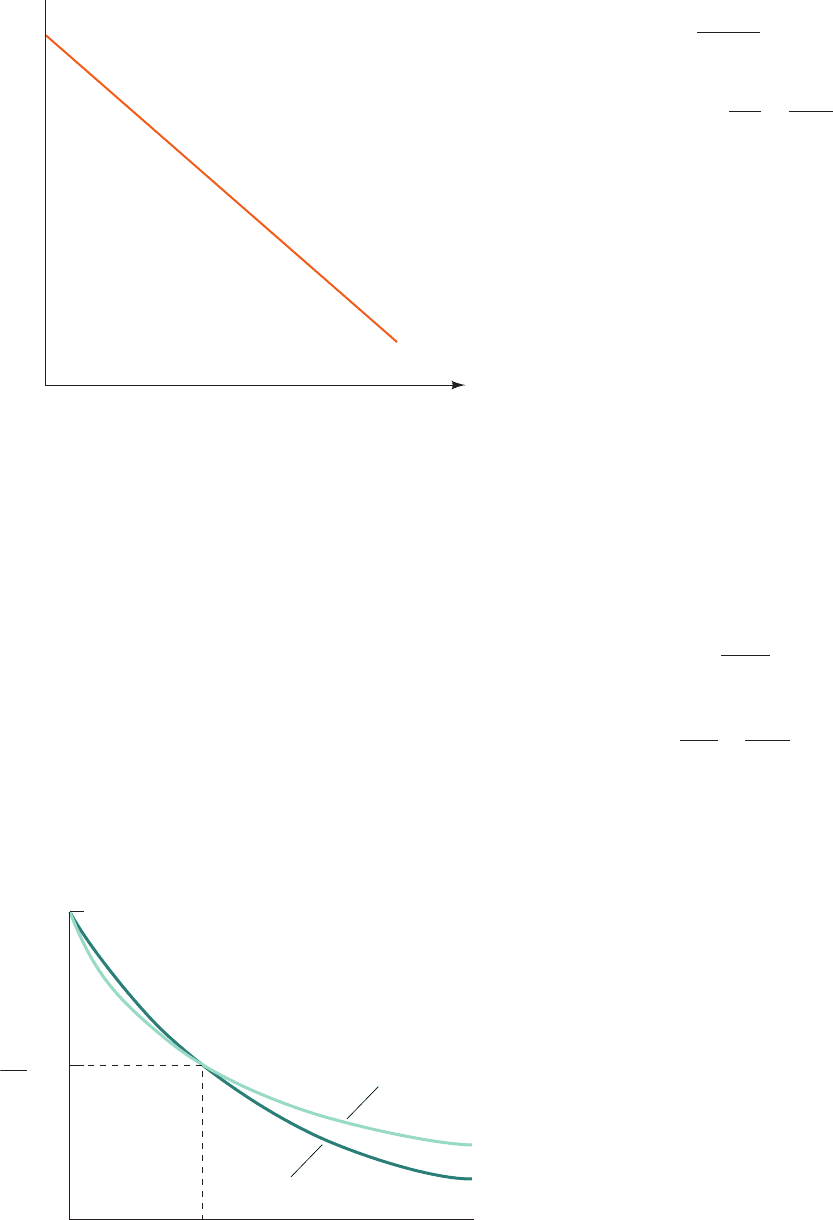
variables ln[A] and t as is diagrammed in Fig. 14-1. There-
fore, if a reaction is first order, a plot of ln[A] versus t will
yield a straight line whose slope is ⫺k, the negative of the
first-order rate constant, and whose intercept on the ln[A]
axis is ln[A]
o
.
Substances that are inherently unstable, such as radioac-
tive nuclei, decompose through first-order reactions (first-
order processes are not just confined to chemical reactions).
One of the hallmarks of a first-order reaction is that the
time for half of the reactant initially present to decompose,
its half-time or half-life, t
1/2
, is a constant and hence inde-
pendent of the initial concentration of the reactant. This
is easily demonstrated by substituting the relationship
[A] ⫽ [A]
o
/2 when t ⫽ t
1/2
into Eq. [14.4a] and rearranging:
Thus
[14.5]
In order to appreciate the course of a first-order reac-
tion, let us consider the decomposition of
32
P, a radioactive
isotope that is widely used in biochemical research. It has a
half-life of 14 days. Thus, after 2 weeks, one-half of the
32
P
initially present in a given sample will have decomposed;
after another 2 weeks, one-half of the remainder, or three-
quarters of the original sample, will have decomposed; etc.
The long-term storage of waste
32
P therefore presents little
problem, since after 1 year (26 half-lives), only 1 part in
2
26
⫽ 67 million of the original sample will remain. How
much will remain after 2 years? In contrast,
14
C, another
commonly employed radioactive tracer, has a half-life of
5715 years. Only a small fraction of a given quantity of
14
C
will decompose over the course of a human lifetime.
b. Second-Order Rate Equation for One Reactant
In a second-order reaction with one type of reactant,
2A S P, the variation of [A] with time is quite different
from that in a first-order reaction. Rearranging Eq. [14.3b]
and integrating it over the same limits used for the first-
order reaction yields
so that
[14.6]
Equation [14.6] is a linear equation in terms of the vari-
ables 1/[A] and t. Consequently, Eqs. [14.4a] and [14.6] may
be used to distinguish a first-order from a second-order re-
action by plotting ln[A] versus t and 1/[A] versus t and ob-
serving which, if any, of these plots is a straight line.
Figure 14-2 compares the different shapes of the
progress curves describing the disappearance of A in first-
and second-order reactions having the same half-times.
Note that before the first half-time, the second-order
progress curve descends more steeply than the first-order
curve, but after this time the first-order progress curve is
the more rapidly decreasing of the two. The half-time for a
second-order reaction is expressed and
therefore, in contrast to a first-order reaction, is dependent
on the initial reactant concentration.
C. Transition State Theory
The goal of kinetic theory is to describe reaction rates in
terms of the physical properties of the reacting molecules.
A theoretical framework for doing so, which explicitly con-
siders the structures of the reacting molecules and how
they collide, was developed in the 1930s, principally by
Henry Eyring. This view of reaction processes, known as
transition state theory or absolute rate theory, is the foun-
dation of much of modern kinetics and has provided an
t
1>2
⫽ 1>(k[A
o
])
1
[A]
⫽
1
[A]
o
⫹ kt
冮
[A]
[A]
o
⫺
d[A]
[A]
2
⫽ k
冮
t
0
dt
t
1>2
⫽
ln 2
k
⫽
0.693
k
ln a
[A]
o
>2
[A]
o
b⫽⫺kt
1>2
484 Chapter 14. Rates of Enzymatic Reactions
0 Time
Slope = –k
ln[A]
o
ln[A]
t
1/2
1.0
0.5
0
First order
Second order
Time
[A]
[A]
o
Figure 14-1 Plot of ln[A] versus time for a first-order reac-
tion. This illustrates the graphical determination of the rate
constant k using Eq. [14.4a].
Figure 14-2 Comparison of the progress curves for first- and
second-order reactions that have the same value of t
1/2
. [After
Tinoco, I., Jr., Sauer, K., and Wang, J.C., Physical Chemistry. Prin-
ciples and Applications in Biological Sciences (2nd ed.), p. 291,
Prentice-Hall (1985).]
JWCL281_c14_482-505.qxd 6/3/10 12:07 PM Page 484

extraordinarily productive framework for understanding
how enzymes catalyze reactions.
a. The Transition State
Consider a bimolecular elementary reaction involving
three atoms A, B, and C:
Clearly atom C must approach the diatomic molecule
A¬B so that, at some point in the reaction, a high-energy
(unstable) complex represented as exists in
which the A¬B covalent bond is in the process of breaking
while the B¬C bond is in the process of forming.
Let us consider the simplest example of this reaction:
that of a hydrogen atom with diatomic hydrogen (H
2
) to
yield a new H
2
molecule and a different hydrogen atom:
The potential energy of this triatomic system as a function
of the relative positions of its component atoms is plotted
in Fig. 14-3. Its shape is of two long and deep valleys paral-
lel to the coordinate axes with sheer walls rising toward the
axes and less steep ones rising toward a plateau where both
coordinates are large (the region of point b). The two val-
H
A
¬H
B
⫹ H
C
¡
H
A
⫹ H
B
¬H
C
A
p
B
p
C
A¬B ⫹ C
¡
A ⫹ B¬C
leys are joined by a pass or saddle near the origin of the di-
agram (point c). The minimum energy configuration is that
of an H
2
molecule and an isolated atom, that is, with one
coordinate large and the other at the H
2
covalent bond dis-
tance [near points a (the reactants) and d (the products)].
During a collision, the reactants generally approach one
another with little deviation from the minimum energy re-
action pathway (line a—c—d) because other trajectories
would require much greater energy. As the atom and mol-
ecule come together, they increasingly repel one another
(have increasing potential energy) and therefore usually
fly apart. If, however, the system has sufficient kinetic energy
to continue its coalescence, it will cause the covalent bond of
the H
2
molecule to weaken until ultimately, if the system
reaches the saddle point (point c),there is an equal probabil-
ity that either the reaction will occur or that the system will
decompose back to its reactants. Therefore, at this saddle
point, the system is said to be at its transition state and
hence to be an activated complex. Moreover, since the
concentration of the activated complex is small, the decom-
position of the activated complex is postulated to be the rate-
determining process of this reaction.
The minimum free energy pathway of a reaction is
known as its reaction coordinate. Figure 14-4a, which is
Section 14-1. Chemical Kinetics 485
Figure 14-3 Potential energy of
the colinear H ⴙ H
2
system as a
function of its internuclear distances,
R
AB
and R
BC
. The reaction is
represented as (a) a perspective
drawing and (b) the corresponding
contour diagram.The points a and d
are approaching potential energy
minima, b is approaching a
maximum, and c is a saddle point.
[After Frost, A.A. and Pearson, R.G.,
Kinetics and Mechanism (2nd ed.),
p. 80, Wiley (1961).]
Figure 14-4 Transition state diagrams. (a) For the H ⫹ H
2
reaction.This is a section taken along the a—c—d line in
R
AB
R
BC
0
(a)
a
d
b
c
R
BC
R
AB
0
a
d
b
c
(b)
Reaction coordinate
(a)
ad
c
G
H
A
– – – H
B
– – – H
C
H
A
–– H
B
+ H
C
H
A
+ H
B
–– H
C
Reaction coordinate
(b)
G
ΔG
reaction
A + B
P + Q
X
ΔG
Fig. 14-3. (b) For a spontaneous reaction, that is, one in which the
free energy decreases.
JWCL281_c14_482-505.qxd 2/19/10 2:21 PM Page 485

called a transition state diagram or a reaction coordinate
diagram, shows the free energy of the H ⫹ H
2
system along
the reaction coordinate (line a—c—d in Fig. 14-3). It can be
seen that the transition state is the point of highest free en-
ergy on the reaction coordinate. If the atoms in the tri-
atomic system are of different types, as is diagrammed in
Fig. 14-4b, the transition state diagram is no longer sym-
metrical because there is a free energy difference between
reactants and products.
b. Thermodynamics of the Transition State
The realization that the attainment of the transition
state is the central requirement in any reaction process led
to a detailed understanding of reaction mechanisms. For
example, consider a bimolecular reaction that proceeds
along the following pathway:
where X
‡
represents the activated complex. Therefore,
considering the preceding discussion,
[14.7]
where k is the ordinary rate constant of the elementary re-
action and k¿ is the rate constant for the decomposition of
X
‡
to products.
In contrast to stable molecules, such as A and P, which
occur at energy minima, the activated complex occurs at an
energy maximum and is therefore only metastable (like a
ball balanced on a pin). Transition state theory neverthe-
less assumes that X
‡
is in rapid equilibrium with the reac-
tants; that is,
[14.8]
where K
‡
is an equilibrium constant. This central assump-
tion of transition state theory permits the powerful formalism
of thermodynamics to be applied to the theory of reaction
rates.
If K
‡
is an equilibrium constant it can be expressed as
[14.9]
where ⌬G
‡
is the Gibbs free energy of the activated com-
plex less that of the reactants (Fig. 14-4b), T is the absolute
temperature, and R (⫽ 8.3145 J ⴢ K
⫺1
mol
⫺1
) is the gas con-
stant (this relationship between equilibrium constants and
free energy is derived in Section 3-4A). Then combining
Eqs. [14.7] through [14.9] yields
[14.10]
This equation indicates that the rate of a reaction depends
not only on the concentrations of its reactants but also de-
creases exponentially with ⌬G
‡
. Thus, the larger the differ-
ence between the free energy of the transition state and that
of the reactants, that is, the less stable the transition state, the
slower the reaction proceeds.
d[P]
dt
⫽ k¿ e
⫺¢G
‡
>RT
[A][B]
⫺RT ln K
‡
⫽ ¢G
‡
K
‡
⫽
X
‡
[A][B]
d[P]
dt
⫽ k[A][B] ⫽ k¿[X
‡
]
A ⫹ B Δ
K
‡
X
‡
¡
k¿
P ⫹ Q
In order to continue, we must now evaluate k¿, the rate
constant for passage of the activated complex over the
maximum in the transition state diagram (sometimes re-
ferred to as the activation barrier or the kinetic barrier of
the reaction). This transition state model permits us to do
so (although the following derivation is by no means rigor-
ous).The activated complex is held together by a bond that
is associated with the reaction coordinate and that is as-
sumed to be so weak that it flies apart during its first vibra-
tional excursion.Therefore, k¿ is expressed
[14.11]
where n is the vibrational frequency of the bond that
breaks as the activated complex decomposes to products
and k, the transmission coefficient, is the probability that
the breakdown of the activated complex, X
‡
, will be in the
direction of product formation rather than back to reac-
tants. For most spontaneous reactions in solution, k is be-
tween 0.5 and 1.0; for the colinear H ⫹ H
2
reaction, we saw
that it is 0.5.
We have nearly finished our job of evaluating k¿. All
that remains is to determine the value of v. Planck’s law
states that
[14.12]
where, in this case, e is the average energy of the vibration
that leads to the decomposition of X
‡
, and h (⫽ 6.6261 ⫻
10
⫺34
J ⴢ s) is Planck’s constant. Statistical mechanics
tells us that at temperature T, the classical energy of an
oscillator is
[14.13]
where k
B
(⫽ 1.3807 ⫻ 10
⫺23
J ⴢ K
⫺1
) is a constant of nature
known as the Boltzmann constant and k
B
T is essentially
the available thermal energy. Combining Eqs. [14.11]
through [14.13]
[14.14]
Then assuming, as is done for most reactions, that k ⫽ 1
(k can rarely be calculated with any confidence), the combi-
nation of Eqs. [14.7] and [14.10] with [14.14] yields the ex-
pression for the rate constant k of our elementary reaction:
[14.15]
This equation indicates that the rate of reaction decreases as
its free energy of activation, ⌬G
‡
, increases. Conversely, as
the temperature rises, so that there is increased thermal en-
ergy available to drive the reacting complex over the acti-
vation barrier, the reaction speeds up. (Of course, enzymes,
being proteins, are subject to thermal denaturation, so that
the rate of an enzymatically catalyzed reaction falls precip-
itously with increasing temperature once the enzyme’s de-
naturation temperature has been surpassed.) Keep in
mind, however, that transition state theory is an ideal
model; real systems behave in a more complicated, al-
though qualitatively similar, manner.
k ⫽
k
B
T
h
e
⫺¢G
‡
>RT
k¿ ⫽
kk
B
T
h
e ⫽ k
B
T
⫽e>h
k¿ ⫽ kn
486 Chapter 14. Rates of Enzymatic Reactions
JWCL281_c14_482-505.qxd 6/3/10 12:08 PM Page 486
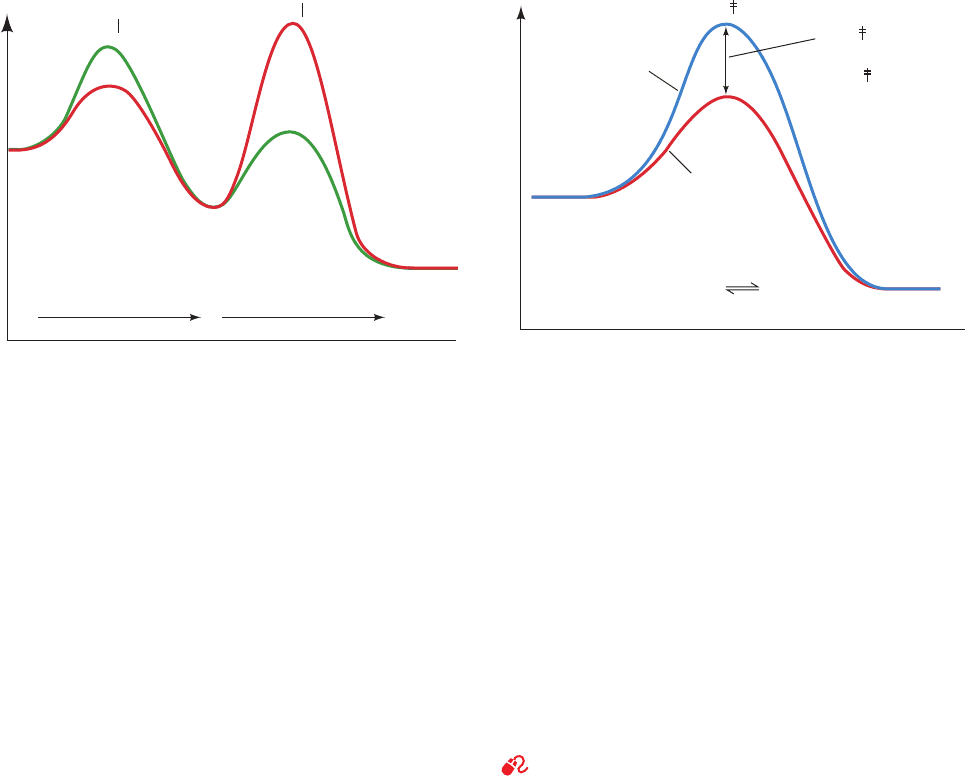
c. Multistep Reactions Have Rate-Determining Steps
Since chemical reactions commonly consist of several
elementary reaction steps, let us consider how transition
state theory treats such reactions. For a multistep reaction
such as
where I is an intermediate of the reaction, there is an acti-
vated complex for each elementary reaction step; the shape
of the transition state diagram for such a reaction reflects
the relative rates of the elementary reactions involved. For
this reaction, if the first reaction step is slower than the sec-
ond reaction step (k
1
⬍ k
2
), then the activation barrier of
the first step must be higher than that of the second step,
and conversely if the second reaction step is the slower
(Fig. 14-5). Since the rate of formation of product P can
only be as fast as the slowest elementary reaction, if one re-
action step of an overall reaction is much slower than the
other, the slow step acts as a “bottleneck” and is therefore
said to be the rate-determining step of the reaction.
d. Catalysis Reduces ⌬G
‡
Biochemistry is, of course, mainly concerned with
enzyme-catalyzed reactions. Catalysts act by lowering the
activation barrier for the reaction being catalyzed (Fig. 14-6).
If a catalyst lowers the activation barrier of a reaction by
then, according to Eq. [14.15], the rate of the reac-
tion is enhanced by the factor . Thus, a 10-fold
rate enhancement requires that ,
less than half the energy of a typical hydrogen bond; a
millionfold rate acceleration occurs when
, a small fraction of the energy of most
covalent bonds. The rate enhancement is therefore a sensi-
tive function of .
Note that the kinetic barrier is lowered by the same
amount for both the forward and the reverse reactions
¢¢G
‡
cat
34.25 kJ ⴢ mol
⫺1
¢¢G
‡
cat
⫽
¢¢G
‡
cat
⫽ 5.71 kJ ⴢ mol
⫺1
e
¢¢G
‡
cat
>RT
¢¢G
‡
cat
A
¡
k
1
I
¡
k
2
P
(Fig. 14-6). Consequently, a catalyst equally accelerates the
forward and the reverse reactions so that the equilibrium
constant for the reaction remains unchanged. The chemical
mechanisms through which enzymes lower the activation
barriers of reactions are the subject of Section 15-1. There
we shall see that the most potent such mechanism often in-
volves the enzymatic binding of the transition state of the
catalyzed reaction in preference to the substrate.
2 ENZYME KINETICS
See Guided Exploration 12: Michaelis–Menten kinetics, Lineweaver–
Burk plots, and enzyme inhibition
The chemical reactions of life
are mediated by enzymes.These remarkable catalysts, as we
saw in Chapter 13, are individually highly specific for partic-
ular reactions. Yet collectively they are extremely versatile
in that the many thousand enzymes now known carry out
such diverse reactions as hydrolysis, polymerization, func-
tional group transfer, oxidation–reduction, dehydration,
and isomerization, to mention only the most common
classes of enzymatically mediated reactions. Enzymes are
not passive surfaces on which reactions take place but,
rather, are complex molecular machines that operate
through a great diversity of mechanisms. For instance, some
enzymes act on only a single substrate molecule; others act
on two or more different substrate molecules whose order
of binding may or may not be obligatory. Some enzymes
form covalently bound intermediate complexes with their
substrates; others do not.
Kinetic measurements of enzymatically catalyzed reac-
tions are among the most powerful techniques for elucidat-
ing the catalytic mechanisms of enzymes. The remainder of
this chapter is therefore largely concerned with the devel-
opment of the kinetic tools that are most useful in the de-
termination of enzymatic mechanisms. We begin, in this
section, with a presentation of the basic theory of enzyme
kinetics.
Section 14-2. Enzyme Kinetics 487
Figure 14-5 Transition state diagram for the two-step overall
reaction A S I S P. For k
1
⬍ k
2
(green curve), the first step is
rate determining, whereas if k
1
⬎ k
2
(red curve), the second step
is rate determining.
Figure 14-6 The effect of a catalyst on the transition state dia-
gram of a reaction. Here .¢¢G
‡
⫽ ¢G
‡
uncat
⫺ ¢G
‡
cat
G
A
I
k
1
< k
2
k
1
> k
2
A
I
P
A
k
1
k
2
IP
Reaction coordinate
=
=
X
ΔΔG
cat
ΔG
(the reduction
in by the
catalyst)
Reaction coordinate
G
A + B
A + B P + Q
P + Q
Catalyzed
Uncatalyzed
JWCL281_c14_482-505.qxd 6/3/10 12:08 PM Page 487
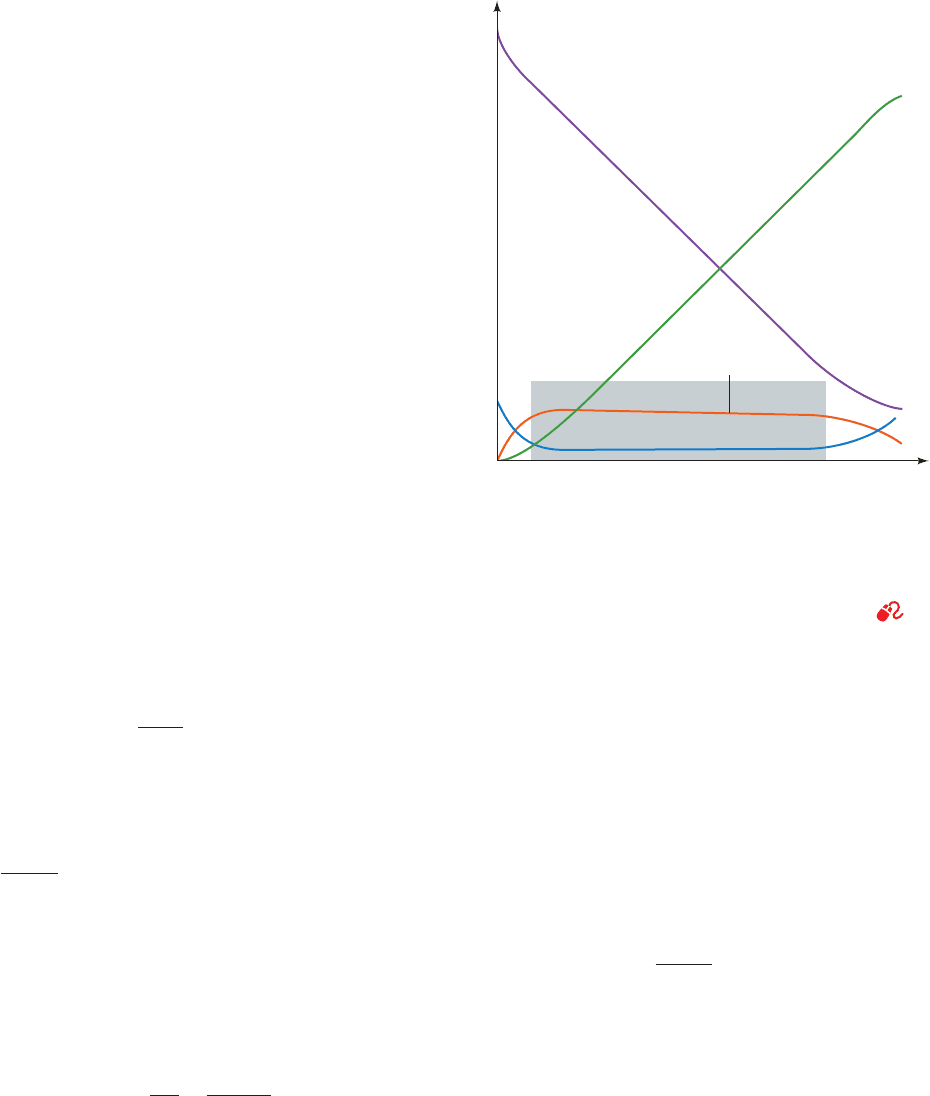
A. The Michaelis–Menten Equation
The study of enzyme kinetics began in 1902 when Adrian
Brown reported an investigation of the rate of hydrolysis
of sucrose as catalyzed by the yeast enzyme invertase (now
known as -fructofuranosidase):
Brown demonstrated that when the sucrose concentration
is much higher than that of the enzyme, the reaction rate
becomes independent of the sucrose concentration; that is,
the rate is zero order with respect to sucrose. He therefore
proposed that the overall reaction is composed of two ele-
mentary reactions in which the substrate forms a complex
with the enzyme that subsequently decomposes to prod-
ucts and enzyme:
Here E, S, ES, and P symbolize the enzyme, substrate,
enzyme–substrate complex, and products, respectively (for
enzymes composed of multiple identical subunits, E refers
to active sites rather than enzyme molecules).According to
this model, when the substrate concentration becomes high
enough to entirely convert the enzyme to the ES form, the
second step of the reaction becomes rate limiting and the
overall reaction rate becomes insensitive to further increases
in substrate concentration.
The general expression for the velocity (rate) of this re-
action is
[14.16]
The overall rate of production of ES is the difference be-
tween the rates of the elementary reactions leading to its
appearance and those resulting in its disappearance:
[14.17]
This equation cannot be explicitly integrated, however,
without simplifying assumptions. Two possibilities are
1. Assumption of equilibrium: In 1913, Leonor
Michaelis and Maud Menten, building on earlier work by
Victor Henri, assumed that k
–1
⬎⬎ k
2
, so that the first step
of the reaction achieves equilibrium.
[14.18]
Here K
S
is the dissociation constant of the first step in the
enzymatic reaction. With this assumption, Eq. [14.17] can
be integrated. Although this assumption is not often cor-
rect, in recognition of the importance of this pioneering
work, the noncovalently bound enzyme–substrate complex
ES is known as the Michaelis complex.
2. Assumption of steady state: Figure 14-7 illustrates
the progress curves of the various participants in the pre-
ceding reaction model under the physiologically common
K
S
⫽
k
⫺1
k
1
⫽
[E][S]
[ES]
d[ES]
dt
⫽ k
1
[E][S] ⫺ k
⫺1
[ES] ⫺ k
2
[ES]
v ⫽
d[P]
dt
⫽ k
2
[ES]
E ⫹ S Δ
k
1
k
⫺1
ES
¡
k
2
P ⫹ E
Sucrose ⫹ H
2
O
¡
glucose ⫹ fructose
condition that substrate is in great excess over enzyme.
With the exception of the initial stage of the reaction, the
so-called transient phase, which is usually over within mil-
liseconds of mixing the enzyme and substrate, [ES] remains
approximately constant until the substrate is nearly ex-
hausted. Hence, the rate of synthesis of ES must equal its
rate of consumption over most of the course of the reac-
tion; that is, [ES] maintains a steady state. One can there-
fore assume with a reasonable degree of accuracy that [ES]
is constant; that is,
[14.19]
This so-called steady-state assumption was first proposed
in 1925 by George E. Briggs and John B.S. Haldane.
In order to be of use, kinetic expressions for overall re-
actions must be formulated in terms of experimentally
measurable quantities. The quantities [ES] and [E] are not,
in general, directly measurable but the total enzyme con-
centration
[14.20]
is usually readily determined. The rate equation for our
enzymatic reaction is then derived as follows. Combining
Eq. [14.17] with the steady-state assumption, Eq. [14.19],
and the conservation condition, Eq. [14.20], yields
k
1
([E]
T
⫺ [ES])[S] ⫽ (k
⫺1
⫹ k
2
)[ES]
[E]
T
⫽ [E] ⫹ [ES]
d[ES]
dt
⫽ 0
488 Chapter 14. Rates of Enzymatic Reactions
Figure 14-7 Progress curves for the components of a simple
Michaelis–Menten reaction. Note that with the exception of the
transient phase of the reaction, which occurs before the shaded
block, the slopes of the progress curves for [E] and [ES] are
essentially zero so long as [S] ⬎⬎ [E]
T
(within the shaded block).
[After Segel, I.H., Enzyme Kinetics, p. 27, Wiley (1975).]
See
the Animated Figures
Time
[S
0
]
[E]
T
[E]
T
= [E] + [ES]
≈ 0
d[ES]
_____
dt
[ES]
[E]
[S] [P]
Concentration
JWCL281_c14_482-505.qxd 2/22/10 8:45 AM Page 488
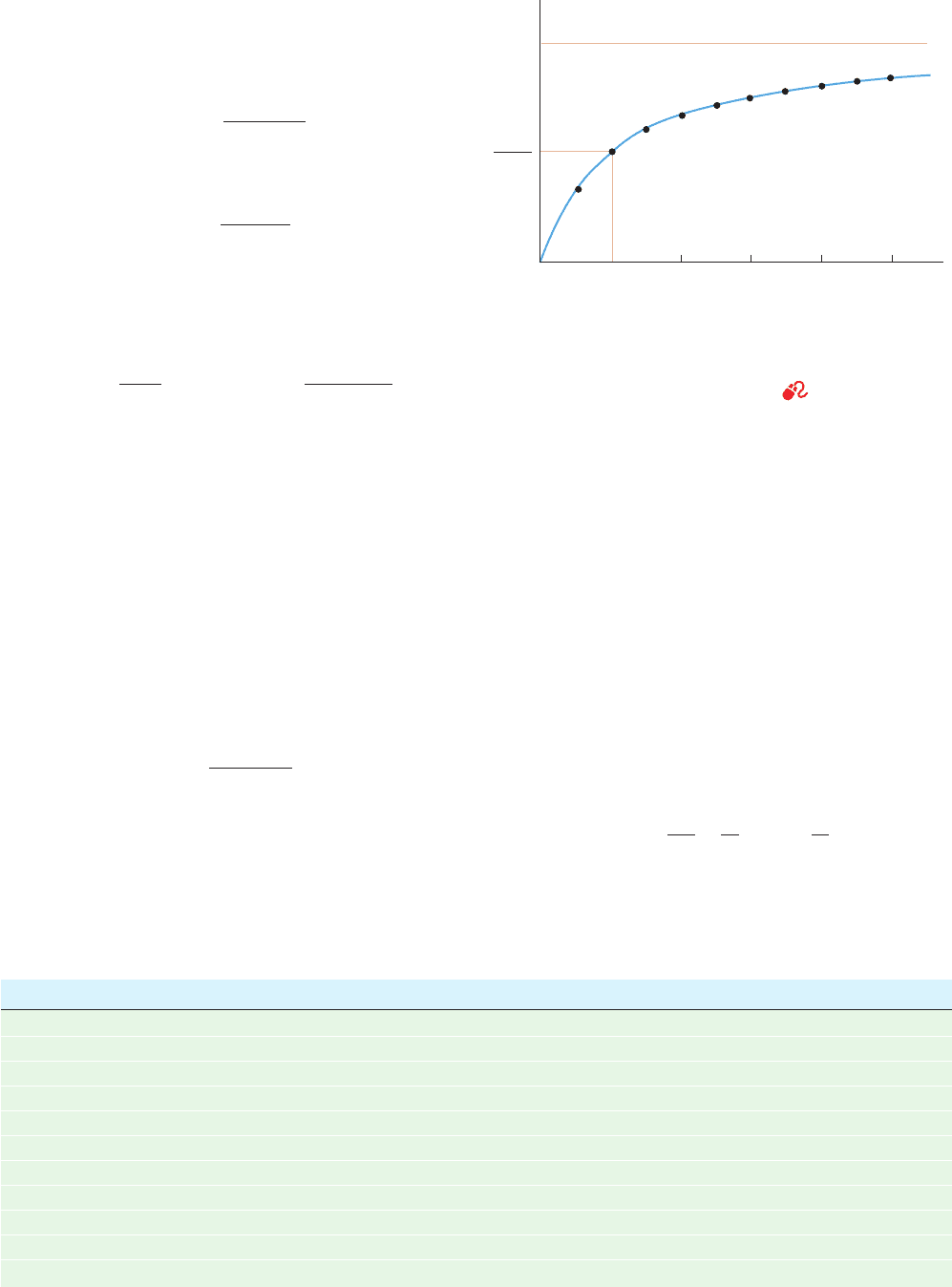
which on rearrangement becomes
Dividing both sides by k
1
and solving for [ES],
where K
M
, which is known as the Michaelis constant, is
defined
[14.21]
The meaning of this important constant is discussed below.
The initial velocity of the reaction from Eq. [14.16] can
then be expressed in terms of the experimentally measura-
ble quantities [E]
T
and [S]:
[14.22]
where t
s
is the time when the steady state is first achieved
(usually milliseconds after t ⫽ 0). The use of the initial ve-
locity (operationally taken as the velocity measured before
more than ⬃10% of the substrate has been converted to
product) rather than just the velocity minimizes such com-
plicating factors as the effects of reversible reactions, inhibi-
tion of the enzyme by product, and progressive inactivation
of the enzyme.
The maximal velocity of a reaction, V
max
, occurs at high
substrate concentrations when the enzyme is saturated,
that is, when it is entirely in the ES form:
[14.23]
Therefore, combining Eqs. [14.22] and [14.23], we obtain
[14.24]
This expression, the Michaelis–Menten equation, is the ba-
sic equation of enzyme kinetics. It describes a rectangular
hyperbola such as is plotted in Fig. 14-8 (although this curve
is rotated by 45° and translated to the origin with respect
to the examples of hyperbolas seen in most elementary
v
o
⫽
V
max
[S]
K
M
⫹ [S]
V
max
⫽ k
2
[E]
T
v
o
⫽ a
d[P]
dt
b
t⫽t
s
⫽ k
2
[ES] ⫽
k
2
[E]
T
[S]
K
M
⫹ [S]
K
M
⫽
k
⫺1
⫹ k
2
k
1
[ES] ⫽
[E]
T
[E]
K
M
⫹ [S]
[ES](k
⫺1
⫹ k
2
⫹ k
1
[S]) ⫽ k
1
[E]
T
[S]
algebra texts). The saturation function for oxygen binding
to myoglobin, Eq. [10.4], has the same functional form.
a. Significance of the Michaelis Constant
The Michaelis constant, K
M
, has a simple operational
definition.At the substrate concentration where [S] ⫽ K
M
,
Eq. [14.24] yields v
o
⫽ V
max
/2 so that K
M
is the substrate
concentration at which the reaction velocity is half-maximal.
Therefore,if an enzyme has a small value of K
M
, it achieves
maximal catalytic efficiency at low substrate concentra-
tions.
The magnitude of K
M
varies widely with the identity of
the enzyme and the nature of the substrate (Table 14-1). It
is also a function of temperature and pH (see Section 14-4).
The Michaelis constant (Eq. [14.21]) can be expressed as
[14.25]
Since K
S
is the dissociation constant of the Michaelis com-
plex, as K
S
decreases, the enzyme’s affinity for substrate
K
M
⫽
k
⫺1
k
1
⫹
k
2
k
1
⫽ K
S
⫹
k
2
k
1
Section 14-2. Enzyme Kinetics 489
Table 14-1 Values of K
M
, k
cat
, and k
cat
/K
M
for Some Enzymes and Substrates
Enzyme Substrate K
M
(M) k
cat
(s
⫺1
) k
cat
/K
M
(M
⫺1
ⴢ s
⫺1
)
Acetylcholinesterase Acetylcholine 9.5 ⫻ 10
⫺5
1.4 ⫻ 10
4
1.5 ⫻ 10
8
Carbonic anhydrase CO
2
1.2 ⫻ 10
⫺2
1.0 ⫻ 10
6
8.3 ⫻ 10
7
2.6 ⫻ 10
⫺2
4.0 ⫻ 10
5
1.5 ⫻ 10
7
Catalase H
2
O
2
2.5 ⫻ 10
⫺2
1.0 ⫻ 10
7
4.0 ⫻ 10
8
Chymotrypsin N-Acetylglycine ethyl ester 4.4 ⫻ 10
⫺1
5.1 ⫻ 10
⫺2
1.2 ⫻ 10
⫺1
N-Acetylvaline ethyl ester 8.8 ⫻ 10
⫺2
1.7 ⫻ 10
⫺1
1.9
N-Acetyltyrosine ethyl ester 6.6 ⫻ 10
⫺4
1.9 ⫻ 10
2
2.9 ⫻ 10
5
Fumarase Fumarate 5.0 ⫻ 10
⫺6
8.0 ⫻ 10
2
1.6 ⫻ 10
8
Malate 2.5 ⫻ 10
⫺5
9.0 ⫻ 10
2
3.6 ⫻ 10
7
Superoxide dismutase Superoxide ion 3.6 ⫻ 10
⫺4
1.0 ⫻ 10
6
2.8 ⫻ 10
9
Urease Urea 2.5 ⫻ 10
⫺2
1.0 ⫻ 10
4
4.0 ⫻ 10
5
(O
2
ⴢ
⫺
)
HCO
⫺
3
Figure 14-8 Plot of the initial velocity v
o
of a simple
Michaelis–Menten reaction versus the substrate concentration
[S]. Points are plotted in 0.5-K
M
intervals of substrate
concentration between 0.5 K
M
and 5 K
M
. See the Animated
Figures
v
o
0
0
K
M
2K
M
3K
M
4K
M
5K
M
[S]
V
max
V
max
2
JWCL281_c14_482-505.qxd 6/3/10 12:08 PM Page 489

increases. K
M
is therefore also a measure of the affinity of
the enzyme for its substrate providing k
2
/k
1
is small com-
pared with K
S
, that is, k
2
⬍ k
–1
.
B. Analysis of Kinetic Data
There are several methods for determining the values of
the parameters of the Michaelis–Menten equation.At very
high values of [S], the initial velocity v
o
asymptotically ap-
proaches V
max
. In practice, however, it is very difficult to as-
sess V
max
accurately from direct plots of v
o
versus [S] such
as Fig. 14-8. Even at such high substrate concentrations as
[S] ⫽ 10 K
M
, Eq. [14.24] indicates that v
o
is only 91% of
V
max
, so that the extrapolated value of the asymptote will
almost certainly be underestimated.
A better method for determining the values of V
max
and
K
M
, which was formulated by Hans Lineweaver and Dean
Burk, uses the reciprocal of Eq. [14.24]:
[14.26]
This is a linear equation in 1/v
o
and 1/[S]. If these quantities
are plotted, in the so-called Lineweaver–Burk or double-
reciprocal plot, the slope of the line is K
M
/V
max
, the 1/v
o
in-
tercept is 1/V
max
, and the extrapolated 1/[S] intercept is
–1/K
M
(Fig. 14-9). A disadvantage of this plot is that most
experimental measurements involve relatively high [S] and
are therefore crowded onto the left side of the graph. Fur-
thermore, for small values of [S], small errors in v
o
lead to
large errors in 1/v
o
and hence to large errors in K
M
and
V
max
.
Several other types of plots, each with its advantages
and disadvantages, have been formulated for the determi-
nation of V
max
and K
M
from kinetic data.With the advent of
conveniently available computers, however, kinetic data
1
v
o
⫽ a
K
M
V
max
b
1
[S]
⫹
1
V
max
are commonly analyzed by mathematically sophisticated
statistical treatments. Nevertheless, Lineweaver–Burk plots
are valuable for the visual presentation of kinetic data as
well as being useful in the analysis of kinetic data from en-
zymes requiring more than one substrate (Section 14-5C).
a. k
cat
/K
M
Is a Measure of Catalytic Efficiency
An enzyme’s kinetic parameters provide a measure of
its catalytic efficiency.We may define the catalytic constant
of an enzyme as
[14.27]
This quantity is also known as the turnover number of an
enzyme because it is the number of reaction processes
(turnovers) that each active site catalyzes per unit time.
The turnover numbers for a selection of enzymes are given
in Table 14-1. Note that these quantities vary by over eight
orders of magnitude depending on the identity of the en-
zyme as well as that of its substrate. Equation [14.23] indi-
cates that for the Michaelis–Menten model, k
cat
⫽ k
2
.For
enzymes with more complicated mechanisms, k
cat
may be a
function of several rate constants.
When [S] ⬍⬍ K
M
, very little ES is formed. Conse-
quently, [E] ⬇ [E]
T
, so that Eq. [14.22] reduces to a second-
order rate equation:
[14.28]
k
cat
/K
M
is the apparent second-order rate constant of the
enzymatic reaction; the rate of the reaction varies directly
with how often enzyme and substrate encounter one an-
other in solution. The quantity k
cat
/K
M
is therefore a meas-
ure of an enzyme’s catalytic efficiency.
b. Some Enzymes Have Attained
Catalytic Perfection
Is there an upper limit on enzymatic catalytic effi-
ciency? From Eq. [14.21] we find
[14.29]
This ratio is maximal when k
2
⬎⬎ k
–1
, that is, when the for-
mation of product from the Michaelis complex, ES, is fast
compared to its decomposition back to substrate and en-
zyme.Then k
cat
/K
M
⫽ k
1
, the second-order rate constant for
the formation of ES. The term k
1
, of course, can be no
greater than the frequency with which enzyme and sub-
strate molecules collide with each other in solution. This
diffusion-controlled limit is in the range of 10
8
to 10
9
M
⫺1
ⴢ
s
⫺1
. Thus, enzymes with such values of k
cat
/K
M
must cat-
alyze a reaction almost every time they encounter a sub-
strate molecule. Table 14-1 indicates that several enzymes,
namely, catalase, superoxide dismutase, fumarase, acetyl-
cholinesterase, and possibly carbonic anhydrase, have
achieved this state of virtual catalytic perfection.
k
cat
K
M
⫽
k
2
K
M
⫽
k
1
k
2
k
⫺1
⫹ k
2
v
o
⬇ a
k
2
K
M
b[E]
T
[S] ⬇ a
k
cat
K
M
b[E][S]
k
cat
⫽
V
max
[E]
T
490 Chapter 14. Rates of Enzymatic Reactions
Figure 14-9 A double-reciprocal (Lineweaver–Burk) plot.
Error bars are ⫾0.05 V
max
.The indicated points are the same as
those in Fig. 14-8. Note the large effect of small errors at small
[S] (large 1/[S]) and the crowding together of points at large [S].
See the Animated Figures
Slope = K
M
/V
max
[S] = 0.5 K
M
[S] = 5 K
M
1/[S]
1/v
o
1/V
max
–1/K
M
0
JWCL281_c14_482-505.qxd 2/19/10 2:21 PM Page 490
